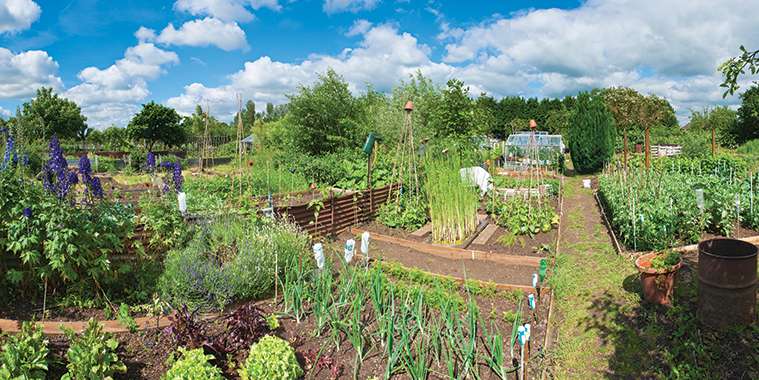Community gardens are a growing addition to many urban neighbourhoods. They provide a space for bartering, collaboration, education, and sometimes pizza! Across Canada, communities are extending their shared spaces to include pizza ovens, beehives, yoga classes and gardening lectures.
Most gardens encourage family members of all ages to participate. The multi-generational approach allows for ideas and resources to be shared with greenhorns and green thumbs alike. And as more and more Canadians show interest in pursuing self-sufficiency and food security by growing their very own menus, it’s time to get involved!
Just keep in mind that COVID-19 may impact how some gardens operate. Your local municipality should have more information on their website.
History 101: The wartime victory gardens
During WWII, “victory gardens” (homegrown vegetable gardens) were promoted by the U.S. and Canadian governments to help alleviate food shortages. Any available greenspace was cleverly converted into a garden. In 1943, Former First Lady Eleanor Roosevelt famously ploughed up the front lawn of the White House to plant her own victory garden. Michelle Obama followed suit, championing the movement supporting sustainable food sovereignty and independence.
I have a pair of gardening gloves. Now what?
While every community garden operates differently, garden plots are generally individually allotted or shared. Plot ‘owners’ are responsible for providing the seeds or plants, watering, and maintaining their allotment. The collectives rely on donations of tools, seeds, rain barrels and sweat equity.
Community gardens usually have an appointed administrator or volunteer responsible for assigning plots, waivers, sharing updates and reminders to members about their roles. Many have a Facebook page or forum while some are operated by the city’s parks and recreation committee. Check your local municipality’s website for contact information.
Some gardens designate plots that are collectively maintained for the purpose of donating all produce to a local food bank or homeless shelter. Other gardens choose to donate a portion of their private harvests in a similar manner.
Other gardens charge a nominal fee, like Banff Community Greenhouse in Alberta. The greenhouse is so popular, organizers had to implement a lottery system for the plots. There’s a $40 annual fee for seeds and a $20 damage fee which is returned at the end of the season if the plot is properly maintained.
The benefits of a community garden
Community gardens let volunteers network with their neighbours, get outdoors, and enjoy 100% local food. In Toronto, Guelph, and Hamilton, fruit and vegetable “gleaning programs” divert produce from becoming waste, which helps support local food banks.
At McGill University’s rooftop garden in Quebec, the “edible campus” bounty is shared with 100 local seniors who enjoy the ultra-fresh vegetables courtesy of Santropol Roulant’s community program. United by food and friendship, the program is one of many creative initiatives across the country. In the County and City of Peterborough, Ontario, 43 community gardens are located in municipal parks, schoolyards, churches, private properties, and communal boulevards making the gardening experience both accessible and inclusive to the region’s residents.
Plotting Ahead
There are many ways to emphasize the ‘community’ aspect of community gardens. Have a scarecrow-making contest, for example. Suggest casual outdoor potlucks for neighbourhood garden members with a guest speaker. Host a recipe and cookbook exchange or preserves swap. Seek out virtual workshops and Zoom lessons. Creating a private or public group forum on Facebook is free and opens a channel of constant communication for members with questions about how to deal with aphids or how to grow pole beans.
The City of Winnipeg operates allotment gardens at various locations throughout the city. Individual garden plots are available for rent through the Community Garden Information Centre at winnipeg.ca
Suggested reading
One excellent source to help you get started is A Community Gardener’s Handbook compiled as a result of requests from the North End Community and found at www.gov.mb.ca This is a month-to-month guide covering the basics of gardening in Winnipeg.
Rob Greenfield’s Food Freedom: A Year of Growing and Foraging 100 Percent of My Food and Why it Matters explores a life not reliant on grocery stores or restaurants. Greenfield has grown more than 100 species of food and believes the “good food revolution” and food freedom is possible if communities assume control, one mighty plot at a time.
The Urban Gardening for Dummies ebook by Paul Simon and Charlie Nardozzi explains the easy way to succeed at urban gardening.
Joining or starting a community garden contributes to a sustainable legacy. The collectives offer networking, friendship and a healthy momentum towards solving the multidimensional food crisis in Canada. There are many such collectives found throughout the city and the province.
— Realtor.ca



